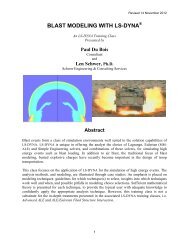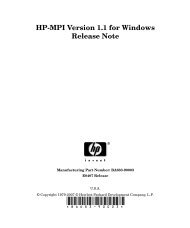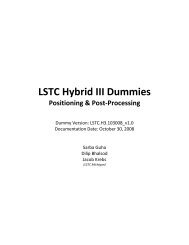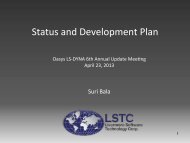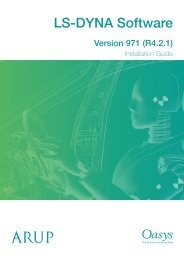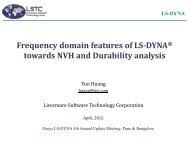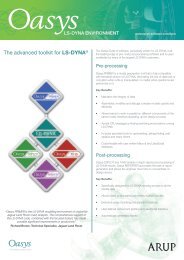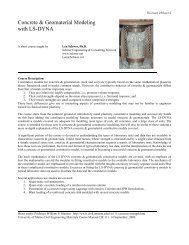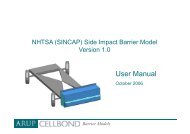Oasys LS-DYNA Environment 8.1 VOLUME 3 ... - Oasys Software
Oasys LS-DYNA Environment 8.1 VOLUME 3 ... - Oasys Software
Oasys LS-DYNA Environment 8.1 VOLUME 3 ... - Oasys Software
You also want an ePaper? Increase the reach of your titles
YUMPU automatically turns print PDFs into web optimized ePapers that Google loves.
<strong>Oasys</strong> <strong>LS</strong>-<strong>DYNA</strong> <strong>Environment</strong>: User Guide (Version <strong>8.1</strong>)<br />
for individual surfaces.<br />
Note that SST, MST, SFST, SFST, SFMT (see *CONTACT) do not apply to types 3, 5 and 10.<br />
If SHLTHK on *CONTROL_CONTACT is non-zero, MAXPEN is ignored and PENCHK is<br />
always 1.<br />
Contact types 4, 13, 14, 15, 16, a3, a5, a10<br />
For these contact types, the contact depth is always limited by element thickness:<br />
shell elements:<br />
thk = min [shell thickness, .4 x min side length, .5 x sqrt (area)]<br />
or thk = user-defined value SST, MST if non-zero.<br />
solid elements:<br />
thk = min [volume/area, .5 x sqrt (area)]<br />
Contact type 26<br />
This contact type uses a segment thickness of 400 times the shell thickness. Spurious penetrations<br />
are avoided because the slave node “remembers” from which side it entered the segment.<br />
CONTACT ON SHEL<strong>LS</strong>: SURFACE OFFSET<br />
The following applies to all single surface contact types, plus types a3, a5, a10, 14, 16:<br />
For contacts on shell elements, impacting nodes first feel a resisting force when half a thickness<br />
from the plane of the shell element. Normally the resisting force is sufficient to maintain the<br />
node in this position, but if the node were forced to continue its motion, the force would rise as<br />
the node approached the element, then reverse as the node crossed to the other side of the<br />
element, reducing to zero as it passed beyond half a thickness from the element. Thus the<br />
thickness of the shell is accounted for, and contact from both sides of the element is permissible.<br />
NOTE:Shell elements may not be initially coincident if they are to contact each other. They<br />
should be offset by the shell thickness.<br />
For contact types 3, 5, 8, 9 and 10, to which the above does not apply, an impacting node first<br />
feels a resisting force as it crosses the plane of the element. If the node were forced to continue<br />
its motion, the resisting force would increase until the maximum penetration depth is reached<br />
(see CONTACT DEPTH above). Contact can occur from one side only; this is determined by<br />
segment orientation, if the surface is defined by segments, or by initial gap if either the surface<br />
is defined by parts or shell elements or ORIEN on *CONTROL_CONTACT is set to 2. Thus<br />
initial gaps are unnecessary ONLY if the surface is defined by segments and ORIEN is 1 or 0.<br />
Page 9.8






